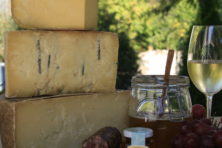The Cheese Insider
- Share
- Tweet
- Pin
- Share
Cheeses can be served in a variety of ways, times, and for different occacasions. I will never forget the time my father, brother and I were visiting relatives in Scotland in the late seventies. My cousin Robin and his wife Winnabelle had us over for dinner one evening, and after we finished a satisfying four-course dinner, they rolled this beautiful cart into the dining room. My first thought was, ‘oh my god, I can’t even think about eating anything else.’ When I looked at what was on the cart I saw nothing but a full tray of beautiful cheeses. Robin began to describe each of the cheeses being offered, including Stilton, a cloth bound cheddar, and a bloomy rind soft cheese. I quickly learned that this was a European tradition, to eat cheese at the end of the meal. In my home we ate cheese, usually cheddar, with Ritz crackers as an appetizer before dinner. Today you will see cheese being served as a dessert course in some of the finest restaurants in America, as well as being on an appetizer course. Cheese can even be a main course, accompanied by lightly dressed salad greens and seasonal fruit.
Many times people will ask our cheesemongers (people that work behind our cheese cases) what they should serve as a cheese plate for a social gathering. How many cheeses, how much of each cheese, and what type of cheese to offer? There are some basic rules that one should consider when serving a cheese plate, although it is really up to the tastes of the host. Flavor and texture matters: a well rounded cheese plate could include a farmstead cheddar, a medium aged gouda, a fruity well aged emmental (Swiss), a fresh chevre (soft goat cheese), and a rich, creamy blue cheese. I prefer having the cheese in a wedge or large piece so that people can cut their own size, versus having the cheese sliced on the plate. I would also recommend that there be a cutting device (small knife) for each of the cheeses. You do not want to be cutting into the gouda with the same knife you used to cut the blue cheese; it could greatly affect the flavor/taste of the milder cheese. I would also recommend that you not include a smoked cheese on a multi cheese plate; the strong flavor of a smoked cheese will drown out the taste of the other cheeses. Best to always serve smoked cheese by itself, let them stand on their own.
It should also be noted that I feel that you are much better off serving 2 – 3 exquisite cheeses on a cheese plate, than serving 4 – 6 mediocre cheeses. You want your guests to enjoy every cheese on the plate, not just some of them.
The cheese being offered on a cheese plate should be served at room temperature, which means it should be left outside a refrigerator at least an hour before serving, preferably covered with a cheese dome, or plastic wrap to prevent the cheese from drying out.
Now the issue of what bread or cracker to serve alongside the cheese plate. Most of us grew up taking a piece of cheese and placing it on a cracker to eat, it’s how everybody was doing it then. My recommendation is to serve good quality French type bread, cut into small pieces. High quality, un-flavored, European style crackers/flatbreads are good as well. We recommend that you enjoy the cheese all by itself, and not placing on a cracker…enjoy the bread all by itself.
When putting together a cheese plate we often are asked how much of each of the cheeses should be served to your guests. If it is more that 2 – 3 cheeses we recommend approximately 1.5 ounces of each cheese per guest. If your cheese plate has 1 or 2 cheeses it is best to figure 2 ounces per guest. None of those rules are etched in stone, but rather a guide for the host to work from. If you are preparing a cheese plate for a tailgate party you might want to bump those numbers up a bit. The perfect pairing for most cheese is a good beer, or white wine, and there always seems to be plenty of that around a tailgate party.
Enjoy serving the fantastic artisan cheeses being produced here in Wisconsin with friends and family, they will be glad you asked them to join you.
Michael C. Thomas is co-owner of Schoolhouse Artisan Cheese with his wife Janice. With locations in Ellison Bay and Egg Harbor, they aim to bring the best of Wisconsin artisan cheeses to Door County, and with “The Cheese Insider” Michael hopes to bring all things cheese to readers of the Pulse.



